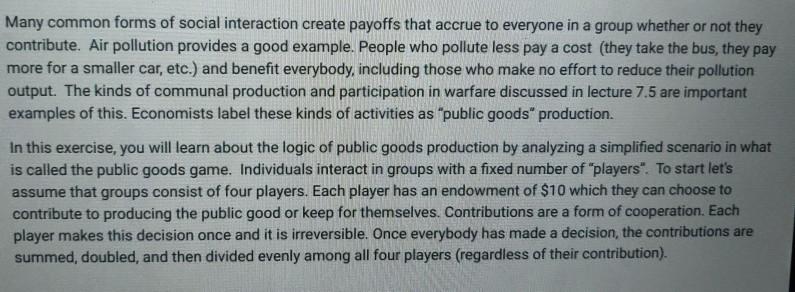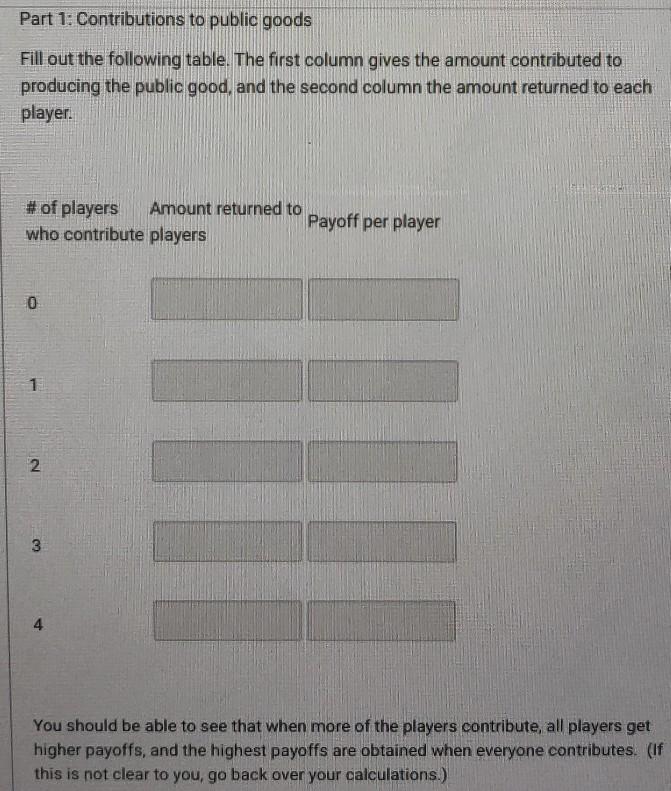Answered step by step
Verified Expert Solution
Question
1 Approved Answer
I'm very confused on how to solve these I have tried 10/20 and it was wrong can you explain how to solve these problems ?



I'm very confused on how to solve these I have tried 10/20 and it was wrong can you explain how to solve these problems ? thank you
This is the only information I was provided I'm sorry the contributors # is 4 (the total amount of people contributing) and they can all only contribute $10
Many common forms of social interaction create payoffs that accrue to everyone in a group whether or not they contribute. Air pollution provides a good example. People who pollute less pay a cost (they take the bus, they pay more for a smaller car, etc.) and benefit everybody, including those who make no effort to reduce their pollution output. The kinds of communal production and participation in warfare discussed in lecture 7.5 are important examples of this. Economists label these kinds of activities as "public goods" production. In this exercise, you will learn about the logic of public goods production by analyzing a simplified scenario in what is called the public goods game. Individuals interact in groups with a fixed number of players". To start let's assume that groups consist of four players. Each player has an endowment of $10 which they can choose to contribute to producing the public good or keep for themselves. Contributions are a form of cooperation. Each player makes this decision once and it is irreversible. Once everybody has made a decision, the contributions are summed, doubled, and then divided evenly among all four players (regardless of their contribution). Part 1: Contributions to public goods Fill out the following table. The first column gives the amount contributed to producing the public good, and the second column the amount returned to each player. # of players Amount returned to Payoff per player who contribute players 0 1 2 3 4 You should be able to see that when more of the players contribute, all players get higher payoffs, and the highest payoffs are obtained when everyone contributes. (If this is not clear to you, go back over your calculations.) Does this mean that everyone should cooperate? To figure this out, you need to know whether an individual could benefit from defecting (not contributing). Let's considera player that is in a group with 4 cooperators. If she defects, her payoff will be that of a noncooperator in a group with 3 cooperators, but she will get to keep her original $10 as well. Her decision to switch from a cooperator to a defector will be based on comparing her payoff if everyone in her group cooperates with her payoff if everyone in the group buther cooperates and she gets to keep her original endoviment More generally to calculate the effect of the switching from cooperation to defection, you have to calculate the reduction in payoff from the public good due to one less cooperator and see whether this is greater or less than $10, the amount an individual defector keeps on top of the public good payoff. You can work this for groups of 1.2. 3. and cooperators by filling in the following table: Per capita payoff cooperators from public good Payoff public good when one Change in public Dooperator goods payoff due switches to to switch noncooperation Overall change in payoff from switching (for the defector) Many common forms of social interaction create payoffs that accrue to everyone in a group whether or not they contribute. Air pollution provides a good example. People who pollute less pay a cost (they take the bus, they pay more for a smaller car, etc.) and benefit everybody, including those who make no effort to reduce their pollution output. The kinds of communal production and participation in warfare discussed in lecture 7.5 are important examples of this. Economists label these kinds of activities as "public goods" production. In this exercise, you will learn about the logic of public goods production by analyzing a simplified scenario in what is called the public goods game. Individuals interact in groups with a fixed number of players". To start let's assume that groups consist of four players. Each player has an endowment of $10 which they can choose to contribute to producing the public good or keep for themselves. Contributions are a form of cooperation. Each player makes this decision once and it is irreversible. Once everybody has made a decision, the contributions are summed, doubled, and then divided evenly among all four players (regardless of their contribution). Part 1: Contributions to public goods Fill out the following table. The first column gives the amount contributed to producing the public good, and the second column the amount returned to each player. # of players Amount returned to Payoff per player who contribute players 0 1 2 3 4 You should be able to see that when more of the players contribute, all players get higher payoffs, and the highest payoffs are obtained when everyone contributes. (If this is not clear to you, go back over your calculations.) Does this mean that everyone should cooperate? To figure this out, you need to know whether an individual could benefit from defecting (not contributing). Let's considera player that is in a group with 4 cooperators. If she defects, her payoff will be that of a noncooperator in a group with 3 cooperators, but she will get to keep her original $10 as well. Her decision to switch from a cooperator to a defector will be based on comparing her payoff if everyone in her group cooperates with her payoff if everyone in the group buther cooperates and she gets to keep her original endoviment More generally to calculate the effect of the switching from cooperation to defection, you have to calculate the reduction in payoff from the public good due to one less cooperator and see whether this is greater or less than $10, the amount an individual defector keeps on top of the public good payoff. You can work this for groups of 1.2. 3. and cooperators by filling in the following table: Per capita payoff cooperators from public good Payoff public good when one Change in public Dooperator goods payoff due switches to to switch noncooperation Overall change in payoff from switching (for the defector)Step by Step Solution
There are 3 Steps involved in it
Step: 1

Get Instant Access to Expert-Tailored Solutions
See step-by-step solutions with expert insights and AI powered tools for academic success
Step: 2

Step: 3

Ace Your Homework with AI
Get the answers you need in no time with our AI-driven, step-by-step assistance
Get Started


